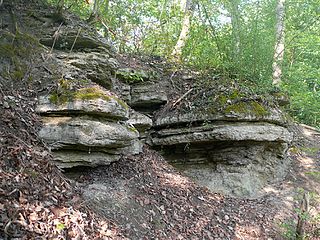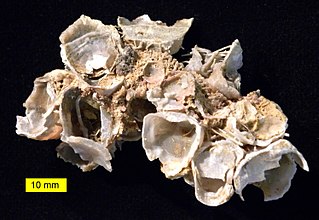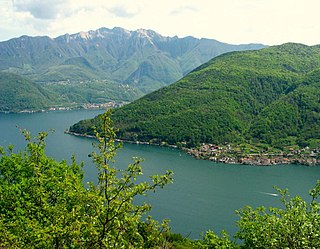Related Research Articles
The Pennsylvanian is, on the ICS geologic timescale, the younger of two subperiods of the Carboniferous Period. It lasted from roughly 323.2 million years ago to 298.9 million years ago. As with most other geochronologic units, the rock beds that define the Pennsylvanian are well identified, but the exact date of the start and end are uncertain by a few hundred thousand years. The Pennsylvanian is named after the U.S. state of Pennsylvania, where the coal-producing beds of this age are widespread.

In the geologic timescale, the Anisian is the lower stage or earliest age of the Middle Triassic series or epoch and lasted from 247.2 million years ago until 242 million years ago. The Anisian Age succeeds the Olenekian Age and precedes the Ladinian Age.
In the geologic timescale, the Artinskian is an age or stage of the Permian. It is a subdivision of the Cisuralian Epoch or Series. The Artinskian likely lasted between 290.1 and 283.5 million years ago (Ma) according to the most recent revision of the International Commission on Stratigraphy (ICS) in 2022. It was preceded by the Sakmarian and followed by the Kungurian.
In the geologic timescale, the Asselian is the earliest geochronologic age or lowermost chronostratigraphic stage of the Permian. It is a subdivision of the Cisuralian Epoch or Series. The Asselian lasted between 298.9 and 293.52 million years ago (Ma). It was preceded by the Gzhelian and followed by the Sakmarian.
The Bashkirian is in the International Commission on Stratigraphy geologic timescale the lowest stage or oldest age of the Pennsylvanian. The Bashkirian age lasted from 323.2 to 315.2 Ma, is preceded by the Serpukhovian and is followed by the Moscovian.

While also using the international geologic time scale, many nations–especially those with isolated and therefore non-standard prehistories–use their own systems of dividing geologic time into epochs and faunal stages.
In the geologic timescale, the Capitanian is an age or stage of the Permian. It is also the uppermost or latest of three subdivisions of the Guadalupian Epoch or Series. The Capitanian lasted between 264.28 and 259.51 million years ago. It was preceded by the Wordian and followed by the Wuchiapingian.
In the geologic timescale, the Sakmarian is an age or stage of the Permian period. It is a subdivision of the Cisuralian Epoch or Series. The Sakmarian lasted between 293.52 and 290.1 million years ago (Ma). It was preceded by the Asselian and followed by the Artinskian.
In the geologic timescale, the Kungurian is an age or stage of the Permian. It is the latest or upper of four subdivisions of the Cisuralian Epoch or Series. The Kungurian lasted between 283.5 and 273.01 million years ago (Ma). It was preceded by the Artinskian and followed by the Roadian.

In the geologic timescale, the Roadian is an age or stage of the Permian. It is the earliest or lower of three subdivisions of the Guadalupian Epoch or Series. The Roadian lasted between 273.01 and 266.9 million years ago (Ma). It was preceded by the Kungurian and followed by the Wordian.
In the geologic timescale, the Wordian is an age or stage of the Permian. It is the middle of three subdivisions of the Guadalupian Epoch or Series. The Wordian lasted between 266.9 and 264.28 million years ago (Ma). It was preceded by the Roadian and followed by the Capitanian.

In the geologic timescale, the Wuchiapingian or Wujiapingian is an age or stage of the Permian. It is also the lower or earlier of two subdivisions of the Lopingian Epoch or Series. The Wuchiapingian spans the time between 259.51 and 254.14 million years ago (Ma). It was preceded by the Capitanian and followed by the Changhsingian.

In the geologic time scale, the Changhsingian or Changxingian is the latest age or uppermost stage of the Permian. It is also the upper or latest of two subdivisions of the Lopingian Epoch or Series. The Changhsingian lasted from 254.14 to 251.9 Ma ago. It is preceded by the Wuchiapingian age/stage and is followed by the Induan age/stage.

In the geologic timescale, the Middle Triassic is the second of three epochs of the Triassic period or the middle of three series in which the Triassic system is divided in chronostratigraphy. The Middle Triassic spans the time between 247.2 Ma and 237 Ma. It is preceded by the Early Triassic Epoch and followed by the Late Triassic Epoch. The Middle Triassic is divided into the Anisian and Ladinian ages or stages.

The Induan is the first age of the Early Triassic epoch in the geologic timescale, or the lowest stage of the Lower Triassic series in chronostratigraphy. It spans the time between 251.9 Ma and 251.2 Ma. The Induan is sometimes divided into the Griesbachian and the Dienerian subages or substages. The Induan is preceded by the Changhsingian and is followed by the Olenekian.

The Ladinian is a stage and age in the Middle Triassic series or epoch. It spans the time between 242 Ma and ~237 Ma. The Ladinian was preceded by the Anisian and succeeded by the Carnian.

The Visean, Viséan or Visian is an age in the ICS geologic timescale or a stage in the stratigraphic column. It is the second stage of the Mississippian, the lower subsystem of the Carboniferous. The Visean lasted from 346.7 to 330.9 Ma. It follows the Tournaisian age/stage and is followed by the Serpukhovian age/stage.
The Kasimovian is a geochronologic age or chronostratigraphic stage in the ICS geologic timescale. It is the third stage in the Pennsylvanian, lasting from 307 to 303.7 Ma. The Kasimovian Stage follows the Moscovian and is followed by the Gzhelian. The Kasimovian saw an extinction event which occurred around 305 mya, referred to as the Carboniferous Rainforest Collapse. It roughly corresponds to the Missourian in North American geochronology and the Stephanian in western European geochronology.

The Gzhelian is an age in the ICS geologic timescale or a stage in the stratigraphic column. It is the youngest stage of the Pennsylvanian, the youngest subsystem of the Carboniferous. The Gzhelian lasted from 303.7 to 298.9 Ma. It follows the Kasimovian age/stage and is followed by the Asselian age/stage, the oldest subdivision of the Permian system.
The Norian is a division of the Triassic Period. It has the rank of an age (geochronology) or stage (chronostratigraphy). It lasted from ~227 to 208.5 million years ago. It was preceded by the Carnian and succeeded by the Rhaetian.
References
- ↑ "GeoWhen Database - Ochoan". timescalefoundation.org.
- ↑ Shen, Shu-Zhong. "The international Permian timescale: March 2013 update" (PDF). Retrieved 6 February 2024.